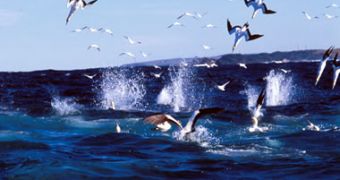1. Gannets and boobies are coastal seabirds famous for their dive for fish. They have been thought to be related to the pelicans, but DNA analysis revealed that their closest relatives are the snakebirds and, more distantly, the cormorants. The oldest known relative of the gannet is the Odontopterix, which lived 50 Ma ago; its relatives had wingspans of 6 m (20 ft). The Plotopteridae were a type of wingless gannets resembling penguins that lived in Oligocene-Miocene (33 to 5 Ma ago).
The proper family of the gannets (Sulidae) is 40 Ma old, while the genus Sula is 30 Ma old. Fossils of 19-15 Ma old gannets were found in France and North America. Fossils from Pleistocene (Ice Age) were found in the islands Rodriguez, Reunion and Madagascar (in the Indian Ocean).
The largest species is the Northern Gannet (Morus bassanus), measuring up to 1 m (3.3 ft) long, having a wingspan of 1.8 m (6 ft) and a weight of 3.6 kg (8 pounds). The smallest species is the Abbott's booby (Papasula abbotti) from the Christmas Island: 71 cm (2.3 ft) long and 1.4 kg (3 pounds) heavy.
2. Gannets plunge with 160 km (100 mi) per hour from a height of 10-40 m (33-133 ft). They catch the fish during the plunge or by diving, using their wings and feet for this purpose. They can remain in immersion for 5-30 minutes, descending to a maximum depth of 30 m (100 ft). In order to buffer the shock of the contact with the water, these birds have a "mattress" made of air sacs situated in the chest area.
The feet membrane includes all four toes and also has the role of incubating plaque during nesting. The eyes are located at the base of the skull, so that the bird can scrutinize the sea before plunging. The birds can see in the water by compressing the crystalline lens. The external nostrils are absent (they open in the roof of the mouth, like in cormorants). Secondary external nostrils, with large commissures and situated on the upper jaw, impede the brutal entrance of water when the birds plunge at high speed.
The birds do not go further than 200 km (125 mi) off the coast and prefer to rest on the water. The usual catch is made of fish 25 to 35 cm (10-14 in) long, like herring, cod, whiting, haddock, sprat, sardine, mackerel and others. On the South American coasts, boobies are endangered by the El Nino phenomenon, which leaves them hungry.
3. Males arrive earliest at the colonies to occupy the nest on the cliffs. Inside a colony, there is a maximum of 2.3 nests per square meter. The distance between the nests is of 60-80 cm (2-2.6 ft). The male makes a nest of algae, grass, feathers and soil with a height of 30-60 cm (1-2 ft). When this one is destroyed, another one comes to replace it.
4. Only one egg is lain. A fishing expedition meant to feed the young can last up to 30 hours, and it can span over a distance of 160-600 km (100-370 mi) away from the nest. The young have black skin and learn to fly by the age of 3 months. At 6 weeks, they grow brown juvenile plumage. In the first year, gannets are brown. At the age of 2-3, they are mottled, and by the age of 4 they are white. They live 16 (maximum 21) years.

 14 DAY TRIAL //
14 DAY TRIAL // 
